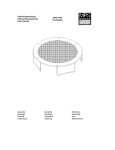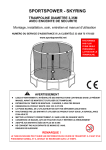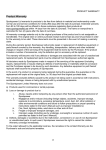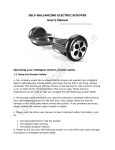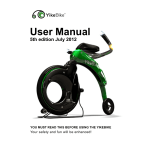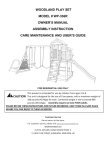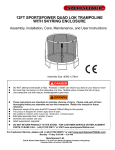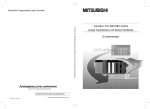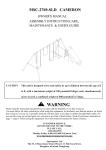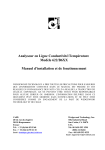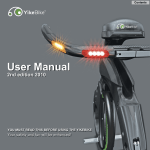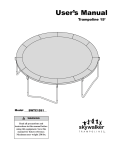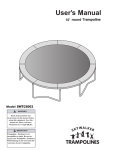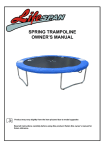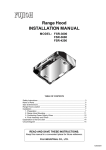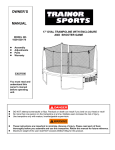Download USER`S MANUAL !
Transcript
13FT TRAMPOLINE DO NOT ALLOW MORE THAN ONE PERSON ON THE TRAMPOLINE AT A TIME. Assembly, Installation, Care, Maintenance, and Use Instructions USER’S MANUAL LT-6005-156+EN ! . WARNING YOU MUST THOROUGHLY READ AND UNDERSTAND INSTRUCTIONS IN THIS MANUAL BEFORE ASSEMBLING AND USE THIS TRAMPOLINE. SAVE THIS MANUAL FOR FUTURE REFERENCE. MAXIMUM WEIGHT OF THE USER SHALL NOT EXCEED 220LBS/100KGS. DO NOT ALLOW YOUNG CHILDREN TO USE UNLESS SUPERVISED BY AN ADULT. CUSTOMER SERVICE Toll Free: 1-866-370-2131 MONDAY-FRIDAY, 9 A.M. - 5 P.M. CENTRAL TIME Dear Customer: Thank you for purchasing this product. For your safety and convenience it is recommended no less than 2 persons participate in the assembly of this product. ! WARNING MAXIMUM WEIGHT OF THE USER SHALL NOT EXCEED 220LBS /100KGS. HINT ASSEMBLY AND MOVING HINTS!! Select a location where you want the trampoline permanently prior to assembly. Do not pick up the frame more than 2 inches off the ground, picking it up too high can cause the frame to warp. If the frame does warp, put the trampoline down, press down on the part that is warped. The tension of the springs will flatten the frame. MOVING THE TRAMPOLINE WARNING If you need to move the trampoline, two or three people are required. All connector points should be wrapped and secured with weather resistant tape, such as duct tape. This will keep the frame intact during the move and prevent the connector points from dislocating and separating. When moving, lift the trampoline slightly off the ground and keep it horizontal to the ground. For any type of other move, you should disassemble the trampoline. WARNING We strongly recommend you do not use the trampoline without an ASTM standard enclosure. If you find the trampoline is being used without an enclosure, stop the user and immediately purchase and install the enclosure. You must make sure that there are no walls, posts, fences, rocks, or any hard or sharp objects within 15 feet of the trampoline. Also, the trampoline must not sit on concrete or any hard surface. WARNING Do not allow children to play or jump on the product when it’s windy or during tornado season or warning. Wind can lift up this equipment and cause serious injury or death. 2 ASSEMBLY AND INSTALLATION INSTRUCTION WARNING PLEASE READ THE ENTIRE INSTRUCTION BOOKLET BEFORE YOU ASSEMBLE OR USE THIS TRAMPOLINE! FOR QUICKER, EASIER AND SAFER ASSEMBLY, MAKE CERTAIN TO FOLLOW INSTRUCTIONS FOR SPRING PLACEMENT. INSTALLATION OF THE TRAMPOLINE MAKE SURE THE ASSEMBLED TRAMPOLINE IS ON LEVEL GROUND! Misuse and abuse of this trampoline is dangerous and can cause serious injury! Trampolines, being a rebounding device, propel the performer to unaccustomed heights and into a variety of body movements. Always inspect the trampoline before each use for worn-out mat, loose or missing parts. Proper assembly, care and maintenance of product, safety tips, warnings, and proper techniques in jumping and bouncing are all included in this manual. All users and supervisors must read and familiarize themselves with these instructions. Anybody who chooses to use this trampoline must be aware of their own limitations in regards to performing various jumps and bounces with this trampoline. WARNING PARALYSIS OR DEATH CAN NO MORE THAN ONE PERSON RESULT IF YOU LAND ON AT A TIME ON THE TRAMPOLINE! YOUR HEAD OR NECK! MULTIPLE JUMPERS INCREASE DO NOT PERFORM THE RISK OF INJURY SUCH AS SOMERSAULTS (FLIPS) AS BROKEN NECK, LEG, BACK THIS WILL INCREASE YOUR OR LIMBS! CHANCES OF LANDING ON YOUR HEAD OR NECK! ALWAYS CONSULT A PHYSICIAN BEFORE PERFORMING ANY KIND OF PHYSICAL ACTIVITY Adequate overhead clearance is essential. A minimum of 24 ft (7.3 meters) from ground level is recommended. Provide clearance for wires, tree limbs, and other possible hazards. Lateral clearance is essential. Place the trampoline away from walls, structures, fences, and other play areas. Maintain a clear space on all sides of the trampoline. Place the trampoline on a level surface before use. Illumination may be required for shady areas and in-door areas. Secure the trampoline against unauthorized and unsupervised use. Remove any obstructions from beneath the trampoline. The owner and supervisors of the trampoline are responsible to make all users aware of practices specified in the use instructions. Do not attempt or allow somersaults. Landing on the head or neck can cause serious injury, paralysis or death, even when landing in the middle of the bed. Do not allow more than one person on the trampoline. Use by more than one person at the same time can result in serious injury. Use trampoline only with mature, knowledgeable supervision. For additional information concerning the trampoline equipment, contact the manufacturer. 3 WARNING Trampolines over 20 inches (51 cm) tall are not recommended for use by children under 6 years of age. Max. weight limit: 220lbs/100kgs. Inspect the trampoline before each use. Make sure the frame padding is correctly and securely positioned. Replace any worn, defective, or missing parts. Climb on and off the trampoline, it is a dangerous practice to jump from the trampoline to the floor or ground when dismounting, or to jump onto the trampoline when mounting. Do not use the trampoline as a springboard to other objects. Stop bounce by flexing knees as feet come in contact with the trampoline bed. Learn this skill before attempting others. Learn fundamental bounces and body positions thoroughly before trying more advanced skills. A variety of trampoline activities can be carried out by performing the basic fundamentals in various series and combinations, performing one fundamental after another, with or without feet bounces between them. Avoid bouncing too high. Stay low until bounce is under control and repeated landing in the center of the trampoline can be accomplished. Control is more important than height. While keeping the head erect, focus eyes on the trampoline toward the perimeter. This will help control bounce. Avoid bouncing when tired. Properly secure the trampoline when not in use. Protect it against unauthorized use. If a trampoline ladder is used, the supervisor should remove it from the trampoline when leaving the area to prevent unsupervised access by children under 6 years of age. Trampolines not recommended for children under six years of age. Keep objects away which could interfere with the performer. Maintain a clear area around the trampoline. Do not use the trampoline while under the influence of alcohol or drugs. For further information or additional instruction materials on skill training, contact a competent trampoline instructor. Bounce only when the surface of the bed is dry. Wind or air movement should be calm and gentle. The trampoline must not be used in gusty or severe winds. Read all instructions before using the trampoline, warnings and instructions for the care, maintenance, and use of this trampoline are included to promote safe, enjoyable use of this equipment. Always start your jump at the broken circle printed on the center of the trampoline mat. When you land more than 1 foot away from the edge of the broken circle, stop your jump immediately!! Restart your jump at the broken circle. TRAMPOLINE PLACEMENT The minimum overhead clearance required is 24 feet (7.3 meters). In terms of horizontal clearance, please ensure that no hazardous objects are near the trampoline such as tree limbs, other recreational objects (i.e. swing sets, swimming pools), electrical power wiring, walls, fences, etc. For safe use of the trampoline, please be aware of the following when selecting a place for your trampoline: Make sure it is placed on a level surface. The area is well-lighted. Artificial illumination maybe required for shady areas. Remove any obstructions from beneath the trampoline. When not in use, the trampoline shall be secured against unauthorized use. The surface of the jump bed shall be dry. Do not jump on wet bed. Wind or air movement shall be calm and gentle. Do not use trampoline in gusty or severe wind. Person in charge and responsible for use of the trampoline shall make users aware of practices specified in this manual. Person in charge shall be a qualified adult. This person shall always be present, when trampoline is in use. Do not place trampoline on concrete floor, hard ground surface (i.e. rock) or slippery surface. Do not use indoors. 4 WARNING If you do not follow these guidelines, you increase the risk of someone getting injured. This trampoline was designed and manufactured with quality materials and craftsmanship. If proper care and maintenance is provided, it will provide all jumpers with years of exercise, fun, and enjoyment as well as reduce the risk of injury. Please follow the guidelines listed below: This trampoline is designed to withhold a certain amount of weight and use. Please make sure that only one person at any one time uses the trampoline. Also, the person should not exceed 220 lbs (100 kgs). Jumpers should either wear socks, gymnastics shoes, or be barefoot when using the trampoline. Please be aware that street shoes or tennis shoes should NOT be worn while using the trampoline. In order to prevent the trampoline mat from getting cut or damaged, please do not allow any pets onto the mat. Also, jumpers should remove all sharp objects from their person prior to using the trampoline. Any type of sharp or pointed objects should be kept off the trampoline mat at all times. Always inspect the trampoline before each use for worn, abused or missing parts. A number of conditions could arise that may increase your chances of getting injured. Please be aware of: ¾ Punctures, frays, tears, or holes worn in the bed or frame padding, barrier or support system (frame) padding ¾ Missing, improperly positioned or insecurely attached frame padding or barrier or enclosure support system (frame) padding and pole caps ¾ Sagging trampoline mat or barrier ¾ Loose stitching or any kind of deterioration of the mat, barrier or support system (frame) padding ¾ Bent or broken frame parts (legs and/or rails) ¾ Broken, missing, or damaged springs ¾ Damaged, missing or insecurely attached frame pad ¾ Protrusions of any types (especially sharp typed) on the frame, springs, mat or suspension IF YOU FIND ANY OF THE PREVIOUS CONDITIONS, OR ANYTHING ELSE THAT YOU FEEL COULD CAUSE HARM TO ANY USER, THE TRAMPOLINE SHOULD BE DISASSEMBLED OR SECURED FROM USE UNTIL THE CONDITION(S) HAS BEEN RESOLVED. WINDY CONDITIONS In severe wind situations, the trampoline can be blown about. If you expect windy weather conditions, the trampoline should be moved to a sheltered area or disassembled. Another option is to tie the round, outside portion (top frame) of the trampoline to the ground using ropes and stakes. If this is done, be sure to secure the tie down to middle of a frame piece. To ensure security, at least four (4) tie downs should be used. Do not just secure the legs of the trampoline to the ground because they can pull out the frame sockets. TRAMPOLINES OVER 20 INCHES (51CM) TALL ARE NOT RECOMMENDED FOR USE BY CHILDREN UNDER 6 YEARS OF AGE. DO NOT USE INDOORS. 5 USE INSTRUCTION WARNING z z z z z z z z Initially, you should get accustomed to the feel and bounce of the trampoline. The focus must be on the fundamentals of your body position and you should practice each bounce (the basic bounces) until you can do each skill with ease and control. To break a bounce, all you need to do is flex your knees sharply before they come in contact with the mat of the trampoline. This technique should be practiced while you are learning each of the basic bounces. The skill of braking should be used whenever you lose balance or control of your jump. Always learn the simplest bounce first and be consistent with the control of your bounce before moving on to more difficult and advanced bounces. A controlled bounce is one when your take off point and landing point is the same spot on the mat. If you move up to the next bounce without first mastering the previous, you increase your chances of getting injured Do not bounce on the trampoline for extended periods of time because fatigue can increase your chance of injury. Bounce for a brief period of time and then allow others to join in on the fun! Never have more than one person bouncing on the trampoline. Jumpers should wear T-shirt, shorts or sweats, and regulation gymnastics shoes, heavy socks, or be barefoot. If you are just beginning, you may want to wear long sleeve shirts and pants to protect against scrapes and abrasions until you master correct landing positions and form. Do not wear hard sole shoes, such as tennis shoes on the trampoline, as this will cause excessive wear on the mat material. You should always mount and dismount properly in order to avoid injury. To mount properly, you should place your hand on the frame and either step or roll up onto the frame, over the springs, and onto the trampoline mat. You should always remember to place your hands onto the frame while mounting or dismounting. Do not step directly onto the frame pad or grasp the frame pad. To dismount properly, move over to the side of the trampoline and place your hand onto the frame as a support and step from the mat to the ground. Smaller children should be assisted when mounting and dismounting the trampoline. Do not bounce recklessly on the trampoline since this will increase your chances of getting injured. The key to safety and having fun on the trampoline is control and mastering the various bounces. Never try to out-bounce another bouncer in terms of height! Never use the trampoline alone without supervision. Trampoline over 20 in. (51cm) tall is not recommended for use by children under 6 years of age. TRAMPOLINE SAFETY INSTRUCTIONS Mounting and Dismounting: Be very careful when getting on and off the trampoline. DO NOT mount the trampoline by grabbing the safety pad, stepping onto the springs, or by jumping onto the mat of the trampoline from any object (i.e. a deck, roof, or ladder). This will increase your chances of getting injured! DO NOT dismount by jumping off the trampoline and landing on the ground, regardless of the makeup of the ground. If small children are playing on the trampoline, they may need help dismounting. Use of Alcohol and Drugs: DO NOT consume any alcohol or drugs when using this trampoline! This will increase your chances of getting injured since these foreign substances impair your judgment, reaction time, and overall physical coordination. 6 Multiple Jumpers: Multiple jumpers (more than one person on the trampoline at any one time), increase the chance of getting injured. Injuries could occur when you fly off the trampoline, lose control, collide with the other jumper(s), or land on the springs. Generally, the lightest person on the trampoline will get injured. No more than one person at a time on the trampoline. Striking the Frame or Springs: When playing on the trampoline, STAY in the center of the mat. This will reduce your risk of getting injured by landing on the frame or springs. Always keeps the safety pad covering the frame of the trampoline. DO NOT jump or step onto the safety pad directly since it was not intended to support the weight of a person. Loss of Control: DO NOT try difficult maneuvers, or any maneuvers until you have mastered the previous maneuver, or if you are just learning how to jump on a trampoline. If you do, you will increase your risk of getting injured by landing on the frame, springs, or off the trampoline completely because you might lose control of your jump. A controlled jump is considered landing on the same spot that you took off from. If you do lose control when you are jumping on the trampoline, bend your knees sharply when you land and this will allow you to regain control and stop your jump. Somersaults (Flips): DO NOT PERFORM somersaults of any type (backwards or forwards) on this trampoline. If you make a mistake when trying to perform a somersault, you could land on your head or neck. This will increase your chances of injuring your neck or back broken, which could result in death or paralysis. Foreign Objects: DO NOT use the trampoline if there are pets, other people, or any objects underneath the trampoline. This will increase the chances of an injury occurring. DO NOT hold any foreign objects in your hand and DO NOT place any objects on the trampoline while anyone is playing on it. Please be aware of what is overhead when you are playing on the trampoline. Tree limbs, wires, or other objects located over the trampoline will increase your chances of getting injured. DO NOT let pets or people underneath the trampoline when not in use. This will increase the chances of an injury occurring. Poor Maintenance of Trampoline: A trampoline in poor condition will increase your risk of getting injured. Please inspect trampoline before each use for bent steel tubes, torn mat, loose or broken springs, and overall stability of the trampoline. Weather Conditions: Please be aware of the weather conditions when using the trampoline. If the mat of the trampoline is wet, the jumper could slip and injure him or herself. If it is too windy, jumpers could lose control. Use trampoline only when the jumping mat is clean and dry. A wet jumping mat is extremely slick and prevents a stable landing. Windy conditions: In severe wind situations, the trampoline can be blown about. If you expect windy weather conditions, the trampoline should be moved to a sheltered area or disassembled. Another option is to tie the round, outside portion (top frame) of the trampoline, to the ground using ropes and stakes. To ensure security, at least four (4) tie downs should be used. Do not just secure the legs of the trampoline to the ground because they can pull out of the frame sockets. 7 Moving the trampoline: If you need to reposition the trampoline, two people should be used. All connector points should be wrapped and secured with weather resistant tape, such as duct tape. This will keep the frame intact during the move and prevent the connector points from dislocating and separating. When moving, lift the trampoline slightly off the ground and keep it horizontal to the ground. Keep the trampoline wheels on the ground for ease of movement. Do not lift at the end where the trampoline wheels are located. For any type of other move, you should disassemble the trampoline. Limit Access: When the trampoline is not in use, always store the access ladder in a secure place so that unsupervised children cannot play on the trampoline. TIPS TO REDUCE THE RISK OF ACCIDENTS All jumpers need to be supervised, regardless of skill level or age. Jumper’s role in accident prevention The key here is to stay in control of your jumps. DO NOT move onto more complicated, more difficult maneuvers until you have mastered the basic, fundamental bounce. Education is also key to safety and very important. Read, understand, and practice all safety precautions and warnings prior to using the trampoline. A controlled jump is when you land and take off from the same location. For additional safety tips and instructions, contact a certified trampoline instructor. Supervisor’s or owner’s role in accident prevention Supervisors need to understand and enforce all safety rules and guidelines. It is the responsibility of the supervisor to provide knowledgeable advice and guidance to all jumpers of the trampoline. If supervision is unavailable or inadequate, the trampoline should be stored in a secure place, disassembled to prevent unauthorized use, or covered with a heavy tarp that can be locked or secured with lock or chains. The supervisor is also responsible to ensure that the safety placard is placed on the trampoline and that jumpers are informed of these warnings and instructions. ADDITIONAL TRAMPOLINE SAFETY INSTRUCTIONS JUMPERS: Do not use trampoline if you have consumed alcohol or drugs Remove all hard and sharp objects from person before using trampoline You should climb on and off in a controlled and careful manner. Never jump on or off the trampoline and never use the trampoline as a device to bounce onto or into another object Always learn the basic bounce and master each type of bounce before trying more difficult types of bounces. Review the Basic Skills Section to learn how to do the basics To stop your bounce, flex your knees when you land on the mat with your feet Always be in control when you are bouncing on the trampoline. A controlled jump is when you land at the same spot that you took off from. If at any time you feel out of control, try to stop your bouncing Do not jump or bounce for prolonged periods of time or too high for a number of jumps Keep your eyes on the mat to maintain control. If you do not, you could lose balance or control Never have more than one person on the trampoline at any one time Always have a supervisor watching you when you are on the trampoline 8 SUPERVISORS: Educate yourself with the basic jumps and safety rules. To prevent and reduce the risk of injuries, enforce all safety rules and ensure that new jumpers learn the basic bounces before trying more difficult and advanced jumps All jumpers need to be supervised, regardless of skill level or age Never use the trampoline when it is wet, damaged, dirty, or worn out. The trampoline should be inspected before any jumpers start bouncing on it Keep all objects that could interfere with the jumper away from the trampoline. Be aware of what is overhead, underneath, and around the trampoline To prevent unsupervised and unauthorized use, the trampoline should be secured when not in use LESSON PLAN The following lessons are suggested in order to learn basic steps and bounces before moving onto more difficult, complicated bounces. Before actually getting on and using the trampoline, you should read and understand all safety instructions. A complete discussion and demonstration of body mechanics and trampoline guidelines should occur between the supervisor and student as well Lesson 1 A. Mounting and Dismounting-Demonstration of proper techniques B. The Basic Bounce-Demonstration and practice C. Braking (Check the Bounce-Demonstration) and practice. Learn to brake on command D. Hands and knees-Demonstration and practice. Stress should be on four-point landing and alignment Lesson 2 A. Review and practice of techniques learned in Lesson 1 B. Knees Bounce-Demonstration and practice. Learn the basic down to knee and back up before trying half twist to left and right C. Seat Bounce-Demonstration and practice. Learn basic seat bounce then add a knee bounce, hands and knees; repeat Lesson 3 A. Review and practice skills and techniques learned in previous lessons B. Front Drop-To avoid mat burns and teach the front bounce position, all students should be requested to assume the prone position (face down on the ground) while the instructor checks for faulty positions that could cause injury C. Start with a hands and knees bounce and then extend body into prone position, and on the mat and return to feet. D. Practice Routine-Hands and knees Bounce, Front Bounce, back to feet, seat bounce, back to feet, seat bounce, back to feet Lesson 4 A. Review and practice skills and techniques learned in previous lessons B. Half-Turn i. Start from front drop position and as you make contact with mat, push off with arms in either the right or left direction and turn head and shoulders in same direction ii. During turn, be sure to keep back parallel to mat and head up iii. After completing turn, land in front drop position 9 After completing this lesson, the student now has a basic foundation of trampoline bounces. Jumpers should be encouraged to try and develop their own routines with the emphasis on control and form A game that can be played in order to encourage students to try develop routines is “BOUNCE”. In this game, players count off from 1 to 10. Player one starts with a maneuver. Player two has to do Player one’s maneuver and add on another. The first person to miss, receives the letter “B”. This continues until someone spells out the word “BOUNCE”. The last remaining contestant is deemed the winner! Even when playing this game, it is important to perform your routines under control and not try difficult or highly skilled bounces that you have not yet mastered. A certified trampoline instructor should be contacted to further develop your trampoline skills. BASIC TRAMPOLINE BOUNCES THE BASIC BOUNCE 1. Start from standing position, feet shoulder width apart and with head up and eyes on mat. 2. Swing arms forward and up and around in a circular motion. 3. Bring feet together while in mid-air and point toes downward. 4. Keep feet shoulder width apart when landing on mat. KNEE BOUNCE 1. Start with basic bounce and keep it low. 2. Land on knees keeping back straight, body erects and uses your arms to maintain balance. 3. Bounce back to basic bounce position by swinging arms up. SEAT BOUNCE 1. Land in a flat sitting position. 2. Place hands on mat besides hips, do not lock your elbow. 3. Return to erect position by pushing with hands. 10 FRONT BOUNCE 1. Start with a low bounce. 2. Land in prone (face down) position and keep hand and arms extended forward on mat. 3. Push off the mat with arms to return to standing position. 180 DEGREE BOUNCE 1. Start with front bounce position. 2. Push off with left or right hands and arms (depending on which way you wish to turn). 3. Maintain head and shoulders in the same direction and keep back parallel to mat and head up. 4. Land in prone position and return to standing position by pushing up with hands and arms WARNING! ALWAYS START YOUR JUMP AT THE BROKEN CIRCLE IN THE MIDDLE OF TRAMPOLINE MAT. WHEN YOU LAND MORE THAN 1 FOOT AWAY FROM THE EDGE OF THE BROKEN CIRCLE, STOP YOUR JUMP IMMEDIATELY!! RESTART YOUR JUMP AT THE BROKEN CIRCLE. 11 TRAMPOLINE PLACEMENT The minimum overhead clearance required is 24 feet (7.3 meters). In terms of horizontal clearance, please ensure that no hazardous objects are near the trampoline such as tree limbs, other recreational objects (i.e. swing sets, swimming pools), electrical power wiring, walls, fences, etc. For safe use of the trampoline, please be aware of the following when selecting a place for your trampoline: ¾ Make sure it is placed on a level surface ¾ The area is well-lit ¾ There are no obstructions beneath the trampoline If you do not follow these guidelines, you increase the risk of someone getting injured ASSEMBLY INSTRUCTIONS To assemble this trampoline, all you need is our special spring loading tool provided with this product. During periods of non-use, this trampoline can be easily disassembled and stored. Please read the assembly instructions before beginning to assemble the product. It is recommended that no less than 2 persons participate in the assembly of this product. PRIOR TO ASSEMBLING Please refer to this page for parts descriptions and numbers. The assembly steps use these descriptions and numbers as reference for your convenience. Make sure that you have all parts listed. If you are missing any parts, please contact the manufactures for instructions on how to attain any parts. To prevent any injuries to your hands from pinch points during assembly, please use gloves to protect your hands. PARTS LIST Reference Number Part Number 1 HJ809 2 3 4 Description Number of Parts HJ810 HJ812 HJ813 Trampoline Mat, stitched with Triangle-Rings Frame Pad Top Rail with Leg Sockets Top Rail 1 4 4 5 6 7 HJ804 HJ805 HJ811 Leg Base Vertical Leg Extension Galvanized Springs – 28N(5.5”) 4 8 80 8 HJ807 Safety Instruction Placard 1 9 HJ808 Spring Loading Tool 1 1 REMEMBER TO USE GLOVES DURING ASSEMBLY TO AVOID PINCHING. AT LEAST TWO PEOPLE NEEDED TO ASSEMBLE THE TRAMPOLINE. 12 ASSEMBLY INSTRUCTIONS z z z Remove all the contents from inside the carton and verify that you have all listed parts as shown on the PARTS LIST. Two adults are required to assemble this trampoline. Please wear heavy duty working gloves when assemble. STEP 1 - Frame layout Please be sure that you should have the following parts: I. Top Rail with Leg socket (HJ812 - ref # 3) 4 pieces II. Top Rail (HJ813 - ref # 4) 4 pieces III. Leg Base (HJ804 - ref # 5) 4 pieces IV. Vertical Leg Extensions (HJ805 - ref # 6) 8 pieces 1. There are a total of 20 pieces of steel tubing parts that are needed to assemble the frame. 2. All parts with the same part # are interchangeable and have no “right” or “left” orientation. 3. Attach a section of tubing with small end to the adjacent section with larger opening, as shown in below ENLARGED DRAWING. 4. These joints are called “connector points”. 3 4 4 CONNETCTOR POINT 3 5 6 STEP 2 – Support Assembly 6 6 A. Slide all Vertical Leg Extensions (ref # 6) onto the Leg Base (ref # 5) as shown in FIGURE 1. Note: The indented mark near the upper end of Vertical Leg Extension is for Enclosure Assembly purpose. It’s not defect. 5 FIGURE 1 13 STEP 3 – Top Rail Assembly 3 FIGURE 2 A. Two people will be necessary at this point to assemble the trampoline. One person lifts the Support Assembly from STEP 2 to a standing (vertical) position and inserts one of the sockets of the Top Rail with Sockets (ref # 3) into the Vertical Leg Extension portion of Support Assembly. The other person holds the other end and inserts that portion into the other Support Assembly as shown in FIGURE 2. You should now have 2 Support Assemblies held together by 1 Top Rail with Socket. 4 FIGURE 3 B. Now, install the other Top Rails (ref # 4) into the gaps between the Vertical Leg Extensions (ref # 6) by inserting them into the slots as shown in FIGURE 3. 14 STEP 4 – Trampoline Mat Assembly Lay out the Trampoline Mat (ref # 1) inside the frame with warning labels facing up as shown in FIGURE 4. There are total of 80 Triangle-rings sewn on the mat, and 80 holes on the Top Rail Frame. None are numbered so please follow the instructions carefully to ensure proper installation. ZERO TRAMPOLINE MAT (ref # 1) FIGURE 4 SPRING LOADING INSTRUCTION CAUTION z Two adults are required in this assembling step. z CAREFUL - When attaching the springs, please do not put your hands, legs, or body close to the connector points. The connector points can become pinch points since the trampoline is tightening up. z Wear heavy duty working gloves to protect your hand. z Use the special spring loading tool included. SPRING LOADING TOOL (ref # 9) 15 STEP 5 Select an arbitrary point on the Top Rail Frame (call it ZERO) as shown in FIGURE 5. ZERO FRAME TRIANGLE-RING TRAMPOLINE MAT (ref # 1) FIGURE 5 STEP 6 Hold the spring loading tool underhand and pull spring hook towards the point “ZERO” on the Top Rail frame as shown in FIGURE 6. Drop hook into frame hole until it latches on completely and tap it down if hook is not completely in the hole. MAT (ref # 1) TRIANGLE-RING SPRINGS FRAME SPRING LOADING TOOL FIGURE 6 ZERO POINT 16 STEP 7 Count holes 40 on the Top Rail and corresponding Triangle-rings, you should be at point 40. Attach a spring at this point as shown in FIGURE 7. ZERO SPRING (ref # 7) TRAMPOLINE MAT (ref # 1) FIGURE 7 40 STEP 8 From point 40, count back 20 holes on the Top Rail and Triangle-rings, you should be at point 20. Attach a spring at this point, as shown in FIGURE 8. ZERO TRAMPOLINE MAT (ref # 1) SPRING (ref # 7) 20 FIGURE 8 40 17 STEP 9 Count another 20 holes from point 40 on the Top Rail and Triangle-rings, you should be at point 60. Attach a spring at this point, as shown in FIGURE 9. At this point in assembly, you should have 4 springs install at ZERO, 20, 40 and 60. This even disbursement of tension is critical to proper assembly of the rest of the trampoline mat as shown in FIGURE 9. ZERO SPRING (ref # 7) TRAMPOLINE MAT (ref # 1) 60 20 FIGURE 9 40 STEP 10 Attach a spring at every 10 holes and corresponding Triangle-rings. For even distribution of tension and ease of assembly, springs should placed on opposite sides of the mat/frame…..i.e. 10 then 50. In addition to the previously installed springs, you should have springs at 10, 30, 50 and 70 as shown in FIGURE 10. SPRING (ref # 7) ZERO 70 10 TRAMPOLINE MAT (ref # 1) 60 50 20 30 FIGURE 10 40 CAUTION: If you notice that you have miscount a hole and Triangle-rings connection, recount and remove or attach any springs required to maintain the count of springs. 18 STEP 11 Attach a spring every 5 holes and corresponding Triangle-ring. In addition to the previously installed, you should have springs at 5, 15, 25, 35, 45, 55, 65 and 75. . STEP 12 Attach a spring every 3 holes and corresponding Triangle-ring. In addition to the previously installed, you should have springs at 3, 8, 13, 18, 23, 28, 33, 38, 43, 48, 53, 58, 63, 68, 73 and 78. STEP 13 Then, attach the remaining 48 springs by using the same theory of counting equal holes. STEP 14 – Safety Placard Attachment Using the tie wrap, attach the Safety Instruction Placard (ref # 8) to the trampoline as shown in FIGURE 11. The tie wrap should go around the Vertical Frame Joint and the Top Rail to ensure that is doesn’t slide off the trampoline. SAFETY PLACARD (ref # 8) FIGURE 11 Frame Pad Assembly WARNING Never use the trampoline without attaching the frame pad. Properly tie down the frame pad before each use!! STEP 15 Lay the Frame Pad (ref # 2) over the trampoline so that the springs and the steel frame are covered. Please ensure that the Frame Pad covers all metal parts. Line up the elastic tie straps as shown below in FIGURE 12 aligning alternate straps over leg socket. FRAME PAD (ref #2) LEG SOCKET ELASTIC STRAP 19 FIGURE 12 STEP 16 Tie straps around leg socket as shown below in FIGURE 13. ELASTIC STRAP FIGURE 13 LEG SOCKET STEP 17 Tie the elastic strap which is near to the jumping mat to the triangle ring with a knot as shown in FIGURE 14. Make sure the knot is tight and the safety pad fits securely on the trampoline. Repeat same manner for all 8 straps. TRIANGLE-RING FRAME PAD (ref # 2) FIGURE 14 ELASTIC STRAP Perform a complete inspection of the trampoline to make sure all parts are assembled and attached properly. Read this entire manual and make sure all jumpers completely understand all of the safety rules printed in the manual and on the various warning signs. Instruct all jumpers in the basic bounces described in the manual. IMPORTANT NOTICE: Make sure the safety pad is securely attached to the frame and completely covers the frame and all springs before using this trampoline. Do not use trampoline if even one spring or Triangle-ring is damaged or missing. DISASSEMBLY To disassemble the trampoline, follow assembly STEP 1 through STEP 17 in reverse order. Do not attempt to disassemble any frame components before the springs and the mat have been removed. Use gloves to protect your hands from pinch points during disassembly. 20 CARE AND MAINTENANCE AND USE INSTRUCTIONS MUST BE READ CAREFULLY BEFORE USING THE TRAMPOLINE! CARE AND MAINTENANCE This trampoline was designed and manufactured with quality materials and craftsmanship. If proper care and maintenance is provided, it will provide all jumpers with years of exercise, fun, and enjoyment as well as reduce the risk of injury. Please follow the guidelines listed below. This trampoline is designed to withhold a certain amount of weight and use. Please make sure that only one person at any one time uses the trampoline. Also, the person should weigh no more than 220 lbs (100 kgs). Please be aware that street shoes or tennis shoes should NOT be worn while using the trampoline. In order to prevent the trampoline mat from getting cut or damaged, please do not allow any pets onto the mat. Also, jumpers should remove all sharp objects from their person prior to using the trampoline. Any type of sharp or pointed objects should be kept off the trampoline mat at all times. Always inspect the trampoline before each use for worn, abused or missing parts. A number of conditions could arise that may increase your chances of getting injured. Please be aware that the following could represent potential hazards: FRAME • A bent or broken frame. • Stretched or ruptured springs. • Sharp protrusions on the frame or suspension system. • Sleeve welds should be painted once per year. Remove any rust, which may exist by using a wire brush. Apply a coat of grey primer enamel spray paint and then a coat of aluminum enamel spray paint, following directions on paint can. JUMPING MAT • Punctures, frays, tears or holes worn in the jumping mat. • Deterioration in the stitching of the jumping mat. • Sagging jumping mat. • Snow on the jumping mat will stretch springs. • Jumping beds must be kept free of dirt particles and sand. • Clean bed surface with cold water but do not use soaps, detergents or chemical cleaners. • Mat can be damaged by belts with large buckles or pants with rivets. Mat is not resistant to scratching. • Shoes should not be worn while using the trampoline. Wear a gymnastic slipper or jump barefoot. • The mat and safety pad are not fire retardant. Keep trampoline away from fire, sparks and fireworks. • Sun can deteriorate the mat fabric and stitching. SAFETY PAD • Punctures, frays, tears or holes in the safety pad. • Deterioration in the stitching of the safety pad. • Missing, improperly positioned or insecurely attached safety pad. • The safety pad could crack if exposed to extreme cold. Safety pad must be in place when using trampoline. WINDY CONDITIONS In severe wind situations, the trampoline can be blown about. If you expect windy weather conditions, the trampoline should be moved to a sheltered area or disassembled. Another option is to tie the round, outside portion (top frame) of the trampoline to the ground using ropes and stakes. If this is done, secure the tie down to the middle of the frame tube. 21 To ensure security, at least four (4) tie downs should be used. Do not just secure the legs of the trampoline to the ground because they can pull out the frame sockets. MOVING THE TRAMPOLINE If you need to move the trampoline, two or three people are required. All connector points should be wrapped and secured with weather resistant tape, such as duct tape. This will keep the frame intact during the move and prevent the connector points from dislocating and separating. For any type of other move, you should disassemble the trampoline. WINTER In areas where there is ice and snow, it is recommended that the trampoline be disassembled and stored for the winter. WARNING!! IF YOU FIND ANY OF THE PREVIOUS CONDITIONS, OR ANYTHING ELSE THAT YOU FEEL COULD CAUSE HARM TO ANY USER, THE TRAMPOLINE SHOULD BE DISASSEMBLED OR SECURED FROM USE UNTIL THE CONDITION(S) HAS BEEN RESOLVED. WARNING !! PLEASE READ ENTIRE INSTRUCTION BOOKLET BEFORE YOU USE THIS TRAMPOLINE. 22 LIMITED WARRANTY SPORTSPOWER LTD. warrants its trampoline products to be free from defects in material and workmanship under normal use and service conditions. The steel frame is warranted for two (2) years after the date of purchase. All other parts are warranted for ninety (90) days after the date of purchase. All warranty coverage extends only to the original retail purchaser from the date of purchase. SPORTSPOWER’S obligation under this Warranty is limited to replacing at SPORTSPOWER’S option. All products for which a warranty claim is made must be received by SPORTSPOWER’S authorized service center, freight prepaid, and accompanied by sufficient proof of purchase. All returns must be preauthorized by SPORTSPOWER. Preauthorization may be obtained by calling SPORTSPOWER Customer Hot Line at 1-866-370-2131. This Warranty does not extend to any product or damage to a product caused by or attributable to freight damage, abuse, misuses, improper or abnormal usage, or repairs not provided by a SPORTSPOWER authorized service center, or to products used for commercial or rental purposes. No other Warranty beyond that specifically set forth above is authorized by SPORTSPOWER. SPORTSPOWER IS NOT RESPONSIBLE OR LIABLE FOR INDIRECT, SPECIAL OR CONSEQUENTIAL DAMAGES ARISING OUT OF OR IN CONNECTION WITH THE USE OR PERFORMANCE OF THE PRODUCT OR OTHER DAMAGES WITH RESPECT TO ANY ECONOMIC LOSS, LOSS OF PROPERTY, LOSS OF REVENUE OR PROFITS, LOSS OF ENJOYMENT OR USE, COST OF REMOVAL, INSTALLATION OR OTHER CONSEQUENTIAL DAMAGES. SOME STATES DO NOT ALLOW THE EXCLUSION OR LIMITATION OF INCIDENTAL OR CONSEQUENTIAL DAMAGES. ACCORDINGLY, THE ABOVE LIMITATION MAY NOT APPLY TO YOU. THE WARRANTY EXTENDED HEREUNDER IS IN LIEU OF ALL OTHER WARRANTIES AND ANY IMPLIED WARRANTY OF MERCHANTABILITY OR FITNESS FOR A PARTICULAR PURPOSE IS LIMITED IN ITS SCOPE AND DURATION TO THE TERMS SET FORTH HEREIN. SOME STATES DO NOT ALLOW LIMITATIONS ON HOW LONG AN IMPLIED WARRANTY LASTS. ACCORDINGLY, THE ABOVE LIMITATION MAY NOT APPLY TO YOU. THIS WARRANTY GIVES YOU SPECIFIC LEGAL RIGHTS. YOU MAY ALSO HAVE OTHER RIGHTS WHICH VARY FROM STATE TO STATE. THIS WARRANTY IS VALID ONLY IN THE UNITED STATES. CUSTOMER SERVICE MONDAY-FRIDAY, 9 A.M. - 5 P.M. CENTRAL TIME Toll Free: 1-866-370-2131 23























